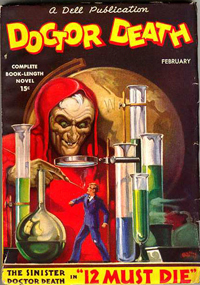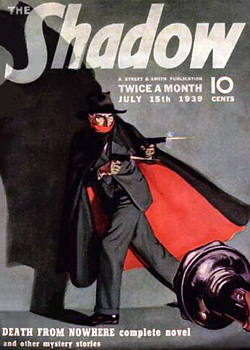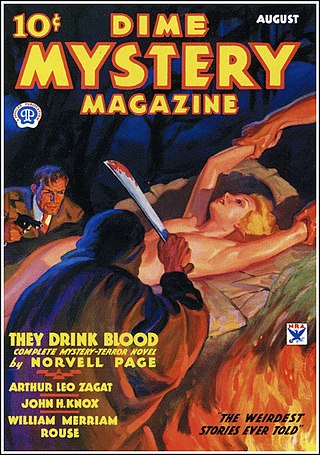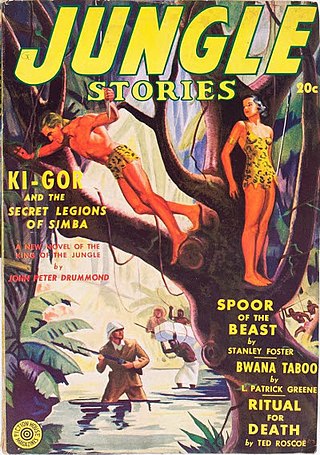
Oriental Stories, later retitled The Magic Carpet Magazine, was an American pulp magazine published by Popular Fiction Co., and edited by Farnsworth Wright. It was launched in 1930 under the title Oriental Stories as a companion to Popular Fiction's Weird Tales, and carried stories with far eastern settings, including some fantasy. Contributors included Robert E. Howard, Frank Owen, and E. Hoffman Price. The magazine was not successful, and in 1932 publication was paused after the Summer issue.

Doctor Death was the title of a short-lived pulp science fiction magazine published by Dell Magazines in 1935, as well as the name of the main character featured in that magazine. Doctor Death was an archcriminal who wanted to return the world to a primitive condition and used supernatural tools such as zombies and magic in his plots against humanity. The stories were written by Harold Ward under the pseudonym of "Zorro". Dell may have intended Doctor Death to be a continuation of a character of the same name in All Detective Magazine, also published by Dell.

The Shadow was an American pulp magazine that was published by Street & Smith from 1931 to 1949. Each issue contained a novel about the Shadow, a mysterious crime-fighting figure who had been invented to narrate the introductions to radio broadcasts of stories from Street & Smith's Detective Story Magazine. A line from the introduction, "Who knows what evil lurks in the hearts of men? The Shadow knows", prompted listeners to ask at newsstands for the "Shadow magazine", which convinced the publisher that a magazine based around a single character could be successful. Walter Gibson persuaded the magazine's editor, Frank Blackwell, to let him write the first novel, The Living Shadow, which appeared in the first issue, dated April 1931.

Strange Stories was a pulp magazine which ran for thirteen issues from 1939 to 1941. It was edited by Mort Weisinger, who was not credited. Contributors included Robert Bloch, Eric Frank Russell, C. L. Moore, August Derleth, and Henry Kuttner. Strange Stories was a competitor to the established leader in weird fiction, Weird Tales. With the launch, also in 1939, of the well-received Unknown, Strange Stories was unable to compete. It ceased publication in 1941 when Weisinger left to edit Superman comic books.

Captain Future was a science fiction pulp magazine launched in 1940 by Better Publications, and edited initially by Mort Weisinger. It featured the adventures of Captain Future, a super-scientist whose real name was Curt Newton, in every issue. All but two of the novels in the magazine were written by Edmond Hamilton; the other two were by Joseph Samachson. The magazine also published other stories that had nothing to do with the title character, including Fredric Brown's first science fiction sale, "Not Yet the End". Captain Future published unabashed space opera, and was, in the words of science fiction historian Mike Ashley, "perhaps the most juvenile" of the science fiction pulps to appear in the early years of World War II. Wartime paper shortages eventually led to the magazine's cancellation: the last issue was dated Spring 1944.

Doc Savage was an American pulp magazine that was published from 1933 to 1949 by Street & Smith. It was launched as a follow-up to the success of The Shadow, a magazine Street & Smith had started in 1931, based around a single character. Doc Savage's lead character, Clark Savage, was a scientist and adventurer, rather than purely a detective. Lester Dent was hired to write the lead novels, almost all of which were published under the house name "Kenneth Robeson". A few dozen novels were ghost-written by other writers, hired either by Dent or by Street & Smith. The magazine was successful, but was shut down in 1949 as part of Street & Smith's decision to leave the pulp magazine field completely.

Science-fiction and fantasy magazines began to be published in the United States in the 1920s. Stories with science-fiction themes had been appearing for decades in pulp magazines such as Argosy, but there were no magazines that specialized in a single genre until 1915, when Street & Smith, one of the major pulp publishers, brought out Detective Story Magazine. The first magazine to focus solely on fantasy and horror was Weird Tales, which was launched in 1923, and established itself as the leading weird fiction magazine over the next two decades; writers such as H.P. Lovecraft, Clark Ashton Smith and Robert E. Howard became regular contributors. In 1926 Weird Tales was joined by Amazing Stories, published by Hugo Gernsback; Amazing printed only science fiction, and no fantasy. Gernsback included a letter column in Amazing Stories, and this led to the creation of organized science-fiction fandom, as fans contacted each other using the addresses published with the letters. Gernsback wanted the fiction he printed to be scientifically accurate, and educational, as well as entertaining, but found it difficult to obtain stories that met his goals; he printed "The Moon Pool" by Abraham Merritt in 1927, despite it being completely unscientific. Gernsback lost control of Amazing Stories in 1929, but quickly started several new magazines. Wonder Stories, one of Gernsback's titles, was edited by David Lasser, who worked to improve the quality of the fiction he received. Another early competitor was Astounding Stories of Super-Science, which appeared in 1930, edited by Harry Bates, but Bates printed only the most basic adventure stories with minimal scientific content, and little of the material from his era is now remembered.

Ka-Zar was an American pulp magazine that published three issues in 1936 and 1937, edited by Martin Goodman. The lead character was modeled after Tarzan and the lead novel and short stories in each issue were adventures set in the jungle.

War Birds was a pulp magazine published by Dell from 1928 to 1937. It was the first pulp to focus on stories of war in the air, and soon had competitors. A series featuring fictional Irishman Terence X. O'Leary, which had started in other magazines, began to feature in War Birds in 1933, and in 1935 the magazine changed its name to Terence X. O'Leary's War Birds for three issues. In these issues the setting for stories about O'Leary changed from World War I to the near future; when the title changed back to War Birds later that year, the fiction reverted to ordinary aviation war stories for its last nine issues, including one final O'Leary story. The magazine's editors included Harry Steeger and Carson W. Mowre.

Captain Hazzard was a science fiction pulp magazine which published one issue in 1938. It was published by Aaron Wyn's Ace Magazines, and edited by Aaron's wife, Rose Wyn. The lead novel, "Python-Men of the Lost City", featured Captain Hazzard, a telepathic superhero; the author's name, "Chester Hawks", was a pseudonym. The magazine also contained some shorter fiction. The lead novel was reprinted in 1974 by Robert Weinberg.

Ace Mystery was a weird menace pulp magazine which published three issues starting 1936, followed by two more under the title Detective Romances. It was published by Periodical House and edited by Harry Widmer. Writers who appeared in the magazine included Frederick C. Davis, who wrote all three lead novels, Hugh B. Cave, and Robert C. Blackmon; magazine historian Michael Cook comments that these were capable writers, but the rest of the magazine was too low-quality to succeed. Some of the stories were fantasy rather than weird menace -- for example, one story was about a sculptor who could shrink dead bodies. Science fiction historian Mike Ashley is more positive than Cook, describing the magazine as "of reasonably good quality", and singling out Charles Marquis Warren's "Coyote Woman" for praise; Ashley quotes pulp historian Robert K. Jones, who considered the "Coyote Woman" "...among the most effective vampire stories to appear in the pulps".

The Spider was an American pulp magazine that was published from 1933 to 1943. It included a lead novel in every issue that featured The Spider, a heroic crimefighter. It was published by Popular Publications, as a rival to Street & Smith's The Shadow and Standard Magazine's The Phantom Detective. Many of the stories involved science fiction plot devices, such as a metal-eating virus, or giant robots.

Dime Mystery Magazine was an American pulp magazine published from 1932 to 1950 by Popular Publications. Titled Dime Mystery Book Magazine during its first nine months, it contained ordinary mystery stories, including a full-length novel in each issue, but it was competing with Detective Novels Magazine and Detective Classics, two established magazines from a rival publisher, and failed to sell well. With the October 1933 issue the editorial policy changed, and it began publishing horror stories. Under the new policy, each story's protagonist had to struggle against something that appeared to be supernatural, but would eventually be revealed to have an everyday explanation. The new genre became known as "weird menace" fiction; the publisher, Harry Steeger, was inspired to create the new policy by the gory dramatizations he had seen at the Grand Guignol theater in Paris. Stories based on supernatural events were rare in Dime Mystery, but did occasionally appear.

Jungle Stories was an American pulp magazine published from 1938 to 1954. The lead stories featured the adventures of Ki-Gor, the son of a Scottish missionary raised in the jungle like Tarzan. For the first two years, the novels formed a continuous narrative, including Ki-Gor meeting Helene Vaughan, a pilot who crashes in the jungle and is saved by Ki-Gor; they later marry. After 1940, the novels were unconnected episodes featuring both of them fighting perils that included some science fictional tropes such as talking gorillas and dinosaurs. The first novel was written by John M. Reynolds; all the later novels were listed under the house name "John Peter Drummond". Some of these were written by Stanley Mullen, but the authors of the others are unknown. Short stories appeared alongside the lead novel in each issue, from authors including Wilbur S. Peacock, Duane Rimel, Dan Cushman, Bryce Walton, and E. Hoffman Price.
The Western Raider was an American pulp magazine. The first issue was dated August/September 1938; it was followed by two more issues under that title, publishing Western fiction, and then was changed to a crime fiction pulp for two issues, titled The Octopus and The Scorpion. Both these two issues were named after a supervillain, rather than after a hero who fights crime, as was the case with most such magazines. Norvell Page wrote the lead novels for both the crime fiction issues; the second was rewritten by Ejler Jakobsson, one of the editors, to change the character from The Octopus to The Scorpion.

The Mysterious Wu Fang was a pulp magazine which published seven issues in 1935 and 1936. Sax Rohmer's Fu Manchu, an oriental villain, was a "yellow peril" stereotype, and Popular Publications wanted to take advantage of the public's interest. The author of all seven lead novels was Robert J. Hogan, who was simultaneously writing the novels for G-8 and His Battle Aces, producing 130,000 to 150,000 words per month; Hogan was told to not to rewrite, but to deliver his first drafts. The hero of the novels was a man named Val Kildare; other characters included a young assistant to Kildare, who was probably added to attract younger readers. The artist John Richard Flanagan, who had experience illustrating Fu Manchu, was hired, but in the opinion of pulp historian Robert Weinberg, "an imitation was an imitation, and the magazine did not sell well". There were short stories along with the lead novel in each issue, also with a "yellow peril" theme; the authors included Steve Fisher, Frank Gruber, O.B. Meyers, and Frank Beaston. The magazine was cancelled after seven issues in favor of a similar magazine with a different villain: Dr. Yen Sin. According to pulp historian Joseph Lewandowski, the decision to switch titles may have been because Wu Fang was too juvenile, and Dr. Yen Sin was supposed to be more mature.

Operator #5 was a pulp magazine published between 1934 and 1939.
Thrilling Mystery was an American pulp magazine published from 1935 to 1944. New York publisher Standard Magazines had a stable of magazines with the "Thrilling" prefix, including Thrilling Detective, Thrilling Love, and Thrilling Adventures, but in 1935, Popular Publications, a rival publisher, launched a weird menace pulp titled Thrilling Mysteries. Standard Magazines sued over the use of the word "Thrilling", and Popular conceded, settling out of court. Thrilling Mysteries was cancelled after a single issue, and in October 1935 Standard began Thrilling Mystery. Like Thrilling Mysteries this was a terror pulp, but it contained less sex and violence than most of the genre, and as a result, in the opinion of science fiction historian Mike Ashley, "the stories had greater originality, although they are not necessarily of better quality". Ashley singles out Carl Jacobi's "Satan's Kite", about a family cursed because of a theft from a temple in Borneo, as worthy of mention. There were two detective stories by Robert E. Howard, the creator of Conan. Other contributors included Fritz Leiber, Fredric Brown, Seabury Quinn, Robert Bloch, and Henry Kuttner. There was little science fiction in the magazine, but some fantasy: pulp historian Robert K. Jones cites Arthur J. Burks "Devils in the Dust" as "one of the most effective" stories, with "a mood as bleak as an arctic blizzard", and Ashley agrees, calling it "particularly powerful".

G-8 and His Battle Aces was an American air-war pulp magazine published from 1930 to 1944. It was one of the first four magazines launched by Popular Publications when it began operations in 1930, and first appeared for just over two years under the title Battle Aces. The success of Street & Smith's The Shadow, a hero pulp, led Popular to follow suit in 1933 by relaunching Battle Aces as a hero pulp: the new title was G-8 and His Battle Aces, and the hero, G-8, was a top pilot and a spy. Robert J. Hogan wrote the lead novels for all the G-8 stories, which were set in World War I. Hogan's plots featured the Germans threatening the Allied forces with extraordinary or fantastic schemes, such as giant bats, zombies, and Martians. He often contributed stories to the magazines as well as the lead novel, though not all the short stories were by him. The cover illustrations, by Frederick Blakeslee, were noted for their fidelity to actual planes flown in World War I.

Battle Birds was an American air-war pulp magazine, published by Popular Publications. It was launched at the end of 1932, but did not sell well, and in 1934 the publisher turned it into an air-war hero pulp titled Dusty Ayres and His Battle Birds, with Robert Sidney Bowen, an established pulp writer, providing a lead novel each month, and also writing the short stories that filled out the issue. Bowen's stories were set in the future, with the United States menaced by an Asian empire called the Black Invaders. The change was not a success, and after a year Bowen wrote a novel in which, unusually for pulp fiction, Dusty Ayres finally defeated the invaders, and the magazine ceased publication. It restarted in 1940, again under the original title, Battle Birds, and lasted for another four years.


















